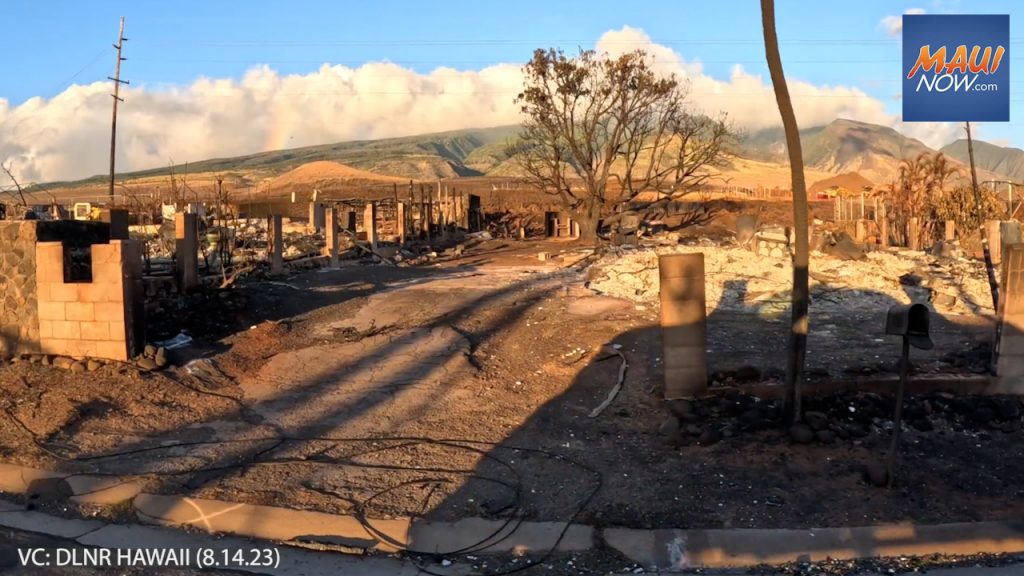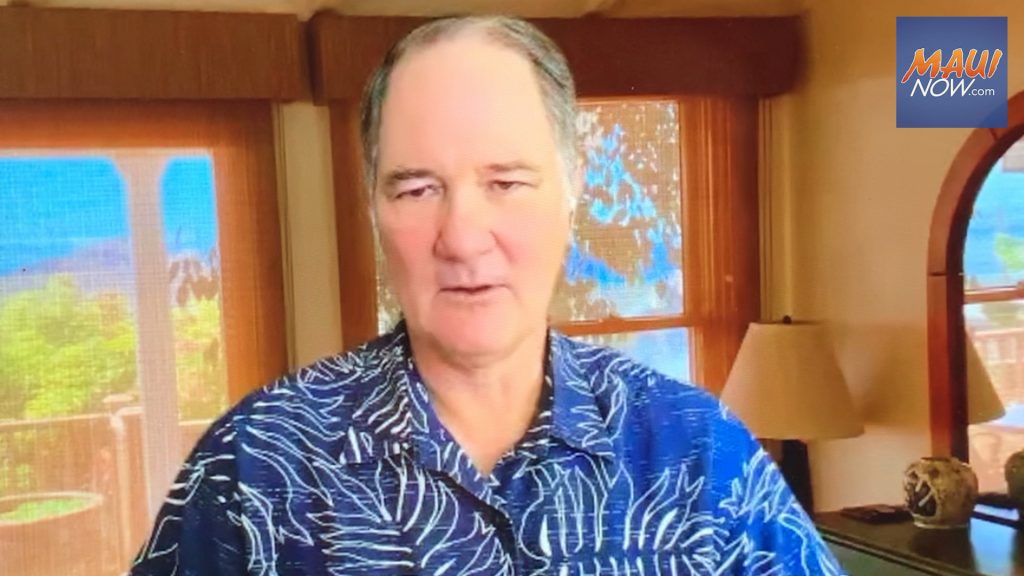UHERO: ‘Wildfires deliver heavy blow to Maui economy,’ rebuilding challenges detailed

The University of Hawaiʻi Economic Research Organization just released its third quarter forecast for 2023, the first since the Maui wildfires. The document assesses the impacts of the fires’ aftermath on the path of Maui’s economy over the next several years, and what that means for the rest of the state.
“The report is very much focused on Maui and what has turned into an extremely sharp downturn in economic activity across the island as a result of the fires, and the loss of visitor spending,” said UHERO Executive Director Carl Bonham in a Zoom media call on Thursday.
The report shows Maui lost more than $13 million of visitor spending each day in the weeks following the fire. “That spread very quickly outside of the Lahaina and West Maui area to impact the entire island,” said Bonham.

In the early days following the Aug. 8 wildfire, visitor arrivals plunged by nearly three-quarters, as travelers responded to early appeals to stay away, according to the UHERO report.
In addition to lost visitor arrivals and spending, Maui is also facing “rapid and severe” effects on employment. “We saw a sharp increase in unemployment claims—over 4,000 in the second week after the fires, and in total, we’re getting close to 10,000 claims for new unemployment benefits since the fire,” said Bonham.
In addition to the displacement of residents directly impacted by the fire’s path, the wildfire also destroyed many businesses and jobs in Lahaina. The UHERO forecast calls for the Maui unemployment rate to soar above 11% in the fourth quarter, and to “only gradually recede,” not dipping below 4% until late 2026.
“That’s going to continue until we really get the visitor spending back,” said Bonham, who said he expects this to be a “relatively slow recovery.”
The state is already seeing the “beginnings of Maui tourism recovery,” according to the UHERO report, with resorts in Central and South Maui to be the first areas to see substantial recovery.
With the planned Oct. 8 reopening of unaffected West Maui resort areas, economists are not anticipating a rush to travel, but a gradual recovery instead.
“While we recognize that West Maui is supposed to reopen in early October, we expect that will be a long drawn out process… For the fourth quarter we expect total visitors to Maui to be roughly 50% of where they were in 2022. So instead of almost 800,000 visitors each quarter, we’re talking about 400,000 visitors in a quarter.”
By the end of 2024, the UHERO forecast calls for visitor arrivals to climb back up to around 80%. After that, gains will be gradual “because of continued temporary housing needs and lingering reluctance of some travelers.”
“The recovery of the overall economy and the tourism economy will be very much influenced in 2024-on by what happens in the housing reconstruction phase, and the need to continue to house displaced residents and emergency workers, and visiting federal employees and eventually construction workers,” said Bonham.
“All of that will come together to essentially slow the process of recovery in the tourism space, but if you look at total payroll jobs in the islands, we’d think that spending of federal dollars will actually make the job recovery look like its faster than the tourist recovery—and it will be faster because of the money that’s being spent.”
Recent job fairs have advertised hiring events for both FEMA and Red Cross, which are looking to hire temporary workers locally to assist in the recovery phase. There’s also job training and workforce certification taking place via the Council for Native Hawaiian Advancement’s Kākoʻo Maui Resource Hub at Maui Mall Village in Kahului.
When looking at the state as a whole, Bonham said it will look like the state economy is doing quite well in 2025 and 2026.
“While Maui is incredibly important to the overall state visitor industry, as a share of the overall economy, it’s just a little bit more than 10% of the state economy. So the overall state economy will weather this Maui downturn, and will actually see a boost in overall economic activity, job growth and particularly construction activity… The economy will grow more slowly and then it will rebound in a sort of typical fashion after a disaster,” he said.
Risk is ‘very real’ to rebuild and still afford to live
As for housing, the report shed some light on the risks involved with rebuilding and the cost a family would incur, living in a rebuilt Lahaina.
The report states: “When reconstruction is eventually complete, the housing stock will be new-build housing in a coveted location. Market prices for this new housing are likely to far exceed the already high prices that existed in Lahaina before the fire.”
Bonham called the risk “very real.”
In order for that risk to not occur, Bonham said there are going to have to be policy changes and a concerted effort to build housing across the entire island.
“I think the risk is very large and the challenge is to grow housing across the entire island and then to allow for workforce housing in and around Lahaina,” said Bonham. “Anything that’s new that isn’t high-density is going to be barely within reach of the median household income—simply because it’s brand new and the bottom line is that new housing is rarely affordable housing.”
Bonham notes that less than 1% of the burn area land is zoned for multi-family. The vast majority, he said, is zoned for either commercial or single family.
“That’s a huge problem, because you take a single family lot in the desirable area, and the incentive is to build a nice home on it. What we need to be able to do is build multi-family housing in a variety of places,” saying changes need to occur in the County’s zoning rules that allow for smaller lot sizes and higher density.
“There’s a challenge there because that’s not historically what was in Lahaina, so if you’re trying to maintain a historic structure, that’s not going to be duplexes and four-story… but that’s the way you get housing done that isn’t million dollar plus homes. You’ve got to have more density,” he said.
The UHERO report notes that modified regulation of short term vacation rentals in Lahaina may also be forthcoming, which could help to mitigate some of the “upward pressure” on demand and prices.
The median price for a single-family home on Maui was last listed at $1,197,500 in August of 2023, according to the Realtors Association of Maui. On top of the median, high mortgage rates have made housing “extremely unaffordable for a typical family,” according to the UHERO report.
“Even if a household could afford a 20% downpayment, in order to keep mortgage payments on the median home below 30% of income, a Maui household would need an annual income of $220,000. Fewer than 10% of Lahaina’s households earn this much,” the report states.
As for renters, about half of the residential population of Lahaina fall into this category.
“While insured homeowners may recoup losses through insurance claims, renters are left with few options for long term housing,” according to the UHERO report.
While the typical renter in Lahaina was paying $1,700/mo. in rent (according to the US Census Bureau), the median priced Craigslist rental listing on Maui is currently $2,500, the report states.
Additional key takeaways outlined in the Sept. 22 report include the following:
- The fire in Lahaina displaced thousands of families, and rebuilding homes will take many years. Homes made up 86% of the roughly 2,200 lost structures, about 3% of Maui’s housing stock. The state and county are working to find longer-term housing for about 7,000 displaced persons who are now being accommodated in hotels, timeshares and temporary vacation rentals. Recovery workers and an eventual army of construction laborers must also be housed. Until substantial rebuilding can be accomplish ed, these needs will press hard on the already tight and expensive Maui housing market.
- While the Maui wildfires will lead to sharp and persistent economic losses on the Valley Isle, spillovers to the rest of Hawaiʻi will be limited. Because Maui represents a significant share of Hawaiʻi tourism, aggregate visitor industry measures will of course fall. And the external conditions that underpin Hawaiʻi tourism remain unsettled. The US economy now looks likely to avoid recession, but further Fed rate increases could upset that. Global conditions have weakened, both in Europe and China, and the renewed fall of the yen will hinder the slow Japanese visitor market recovery.
- Construction projects in other counties will have to compete with Maui recovery needs, but in most sectors we do not expect significant changes from the forecast we were developing before the fires. Statewide job growth will dip below 2% this year and to 1% in 2024. A likely federal government shutdown threatens further disruption. The number of jobs thereafter will be a bit above our previous forecast as rebuilding ramps up.
- Real personal income will be adversely affected by employment losses on Maui, even with federal support for Maui families. Statewide income growth will slow to below 2% in 2024. Gross domestic product will be raised somewhat by rebuilding, but this does not capture the value of lost homes and businesses and the non-pecuniary costs of displacement, trauma and so forth.
- Tax revenues will be hit hard by the disaster. The reopening of West Maui will help to reduce Maui revenue losses, as will Maui’s 0.5% GET surcharge that begins January 1, 2024. The State Council on Revenues has reduced its forecast for State General Fund revenues for fiscal 2024 to just 1.3% growth, down from an earlier estimate of 4%. Depending on the level of federal funding, the state will incur substantial recovery costs for at least the next half-decade.
The authors explained that as more information surfaces regarding Maui’s recovery, the forecast can be refined in the months and years ahead.
UHERO is housed in UH Mānoa’s College of Social Sciences. The full UHERO forecast will be posted HERE.










